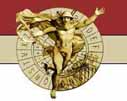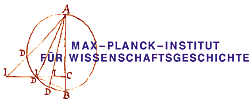


Pratolino: The History of Science in a Garden
Matteo Valleriani
The Garden of Pratolino, located twelve kilometers from Florence on the slopes of the Apennine Mountains, was created during the second half of the XVI century at the command of Grand Duke Francesco I de Medici under the supervision of his chief engineer Bernardo Buontalenti. It immediately turned into one of Europe's greatest marvels not only because of its numerous artistic masterpieces but also because of the high-tech hydraulic system employed in the garden. Its network of aqueducts, its numerous fountains and pneumatic devices and its water-powered automata were all integrated in a single hydraulic system. The Garden of Pratolino represents the material translation of the then recently discovered ancient works of Hero of Alexandria.

Plan of the Garden of Pratolino. From Sgrilli, 1742 |
While designing the Pratolino's water-games in 1582, Buontalenti asked Oreste Vannoccio Biringuccio to translate Hero's Pneumatics into Italian. Buontalenti was seeking inspiration and attempted to establish a connection to the ancient culture via Hellenistic pneumatics, which was re-emerging in this time thanks to the first complete Latin translation compiled seven years earlier in 1575 by Federico Commandino. The commission of the Garden of Pratolino in primis , but also of the gardens of Tivoli, Boboli and the numerous private gardens in particular in Tuscany, in fact laid the foundation for the renaissance of ancient pneumatics. This renaissance did not only incorporate the revival of a theoretical tradition, but also incorporated practical knowledge and the institutions linked to it, such as the Accademia del Disegno.
Documents of an administrative character, sketches and notes of construction as well as reports of travelers are the main sources at our disposal concerning the Pratolino Garden. These sources allow for an investigation of the way in which ancient science and technology were reactivated during early modern times in a process of transformation that resulted in the generation of new knowledge. The project "Pratolino: the History of Science in a Garden" aims to analyze the renaissance of one science, pneumatics, from both a technological and a theoretical perspective, focusing in particular on the mutual interactions and influences of both fields.
This website is one of the outcomes of the project. It has two main targets: firstly to compare the Pratolino Garden of the XVI century with modern situation; secondly to connect all the sources that have been made accessible over the Internet in the context of the garden. The results of the analysis concerned with the comparison between the construction work of Berbardo Buontalenti in the Garden of Pratolino and Hero's Pneumatic are collected into a series of five publications. [See bibliographical data]
Recommended browser: FIREFOX
Credits
The Ente Provincia of Florence acquired the Garden of Pratolino in 1981 from a real estate company into whose hands the glorious Garden had fallen in 1969. The project is headed by the Max Planck Institute for the History of Science in Berlin within the frame of an agreement between the two institutions. The Architect Luigi Ulivieri, Simonetta Merendoni, Anna Lucia de Luca, and Riccardo Campanelli, from the Ente Provincia of Florence lend substantial and relevant organizational and scientific support to the project. The Ente Provincia is credited with the finally launching this project.
Funding is provided by the Ente Provincia, and by the Max Planck Institute for the History of Science and, in addition, by the Cooperation Research Center (CRC) 644 - Transformations of Antiquity. The Moreniana and Riccardiana libraries in Florence, the library of the Max Planck Institute for the History of Science, the Biblioteca Nazionale Centrale of Florence and the Albertina in Vienna are partners of the project.
Dirk Wintergruen, Robert Casties, Malcolm D. Hyman and Julia Damerow from the Max Planck Institute for the History of Science created, updated and maintained the virtual environment, realized in the spirit of an open access policy, upon which this web presentation is based. Julia Damerow moreover produced the creative graphical work, and organized the image repositories and related databases. Simone Rieger, coordinator of the ECHO Project at the Max Planck Institute for the History of Science, supported the project by creating a special section of ECHO's digital library that is dedicated to the history of the Pratolino Garden. Georg Toepfer from the Humboldt University of Berlin supported the establishment of the institutional frame of the project. Lindy Divarci corrected the English texts. Tom Werner supported the biographical work. Monika Liedtke supported the organization of the research trips.
This work is largely indebted to the scientific achievements of Luigi Zangheri from the University of Florence, whose work re-established Pratolino Garden's relevance and reputation it deserves.
This project is part of the research work accomplished in the frame of the interdisciplinary project CRC 644 - "Transformations of Antiquity."
The acute mind and profound skills of the historian of science Jochen Buettner is present in many of the aspects of the project.